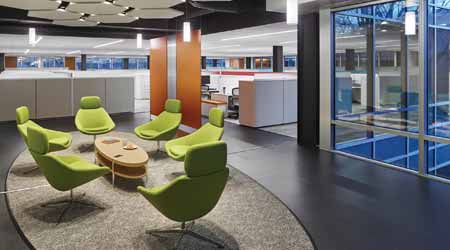 Acoustic ceiling panels arranged in a cloud can be used to define a space while absorbing sound. Photo © Jeffrey Totaro, 2015 / courtesy of Certainteed
Acoustic ceiling panels arranged in a cloud can be used to define a space while absorbing sound. Photo © Jeffrey Totaro, 2015 / courtesy of CertainteedOpen Ceiling Trend Drives Growth in Sound Masking
As open office plans proliferate, the need for sound masking has grown as well.
Along with acoustic ceiling manufacturers, makers of sound masking systems have also had to adjust to the new era of open plenums.
Sound masking has been around for decades. It provides a carefully designed background sound. “It’s raising the noise floor,” says Mark Hughes, senior marketing manager for Cambridge Sound Management. “Instead of hearing things from 50 or 100 feet, maybe you hear them from 10 or 15 feet.”
“You don’t want [sound masking] to be noticed,” says David Smith, vice president of marketing at Lencore. The overall effect should be “like your air conditioner’s running.”
But with the trend toward open office space, masking the sound of nearby voices has gained new importance. Particularly under a high, open ceiling, “you’ve created a space where voices are going to bounce all over the place,” Smith says. “The industry has experienced tremendous growth since 2010. A lot of it is design-driven,” with more hard surfaces and open spaces in workplaces. “People see sound masking as a viable solution.”
Above a suspended ceiling, speakers would typically be pointed upward, to bounce indirect sound off the hard surface and diffuse it through the tile. But in a crowded or short plenum, “direct fire” speakers will be pointed downward. And, in an open space, “you’ll have direct fire because there is no plenum to fill,” Smith says.
When facility managers began asking for sound masking systems in open spaces, manufacturers had to redesign their speakers to fit the look. The previous generation, Smith says, “looked like a paint can hanging from the ceiling.” Now speakers are miniaturized, and often match the look and color of the LED lighting system.
“The increasing complexity of ceiling systems means increasing complexity of sound masking,” says Nik Moeller, vice president of K.R. Moeller Associates. “You see a quiltwork of different types of ceilings — some open, some more absorptive, some gypsum.” And each ceiling environment may need a separate tuning of the masking system.
Small zones of sound allow for a more consistent result across the entire work space. Newer networked technology allows speakers, or groups of speakers, to be adjusted separately. Moeller’s company doesn’t want any zones of more than three speakers. “The second you make zones bigger, you’re not able to tune them as precisely,” he says.
If a space changes its form (such as new walls) or function (going from lobby to workspace, or vice versa), Moeller recommends calling a technician to re-adjust the masking. But automated software now means that the job takes two or three minutes per zone, instead of half an hour. Or, Hughes says, someone at the facility may be able to do it, with a call to tech support.
Ideally, no one notices a sound masking system at all, meaning that stepping from a hallway into an office or conference room should be seamless. Going from a background hum to silence “draws negative attention,” Moeller says. “It’s like having a 15-degree temperature swing.”
David Lewellen is a freelance writer who covers facility issues.
Email comments and questions to edward.sullivan@tradepress.com.
Related Topics:














